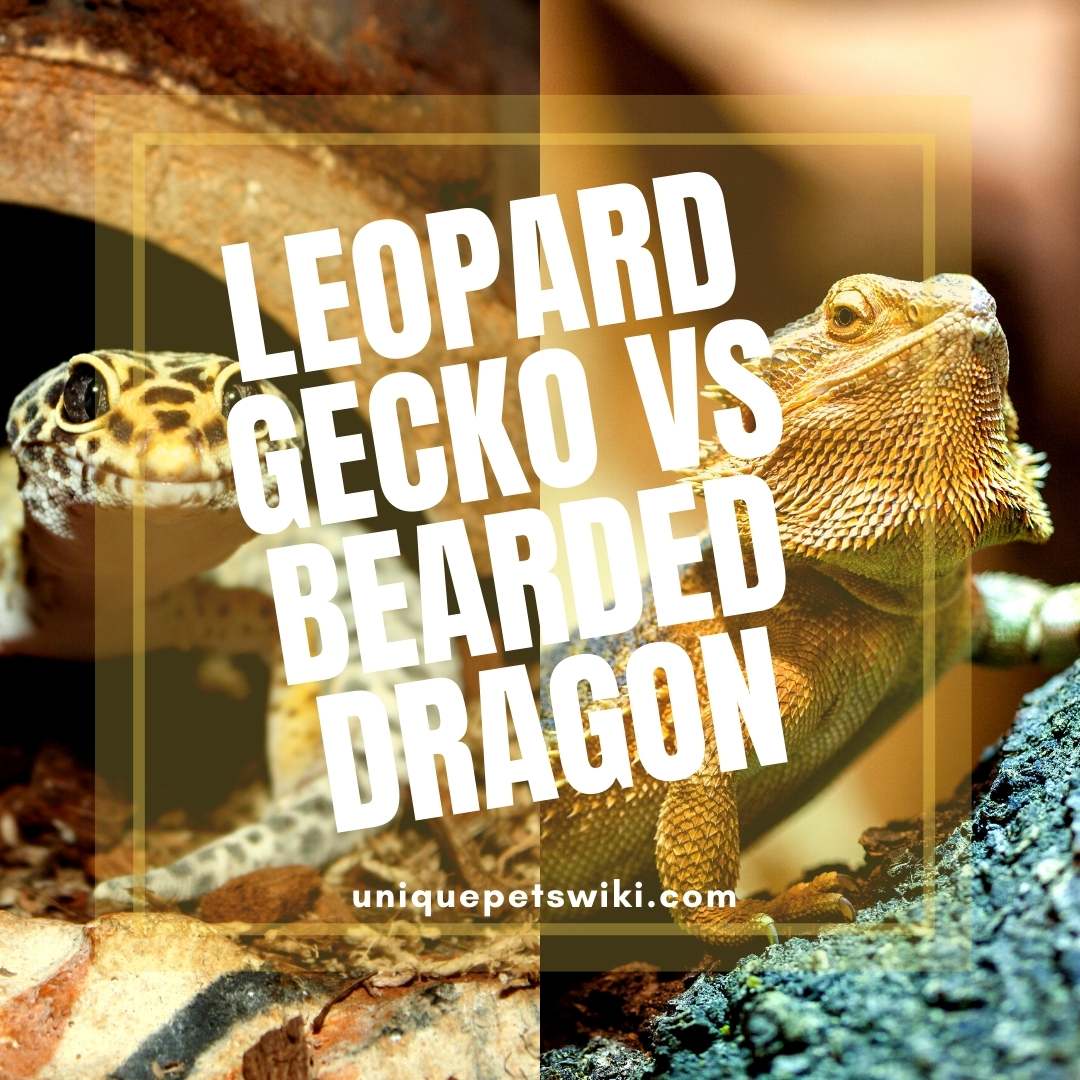Leopard geckos and bearded dragons are definitely among the popular pet reptiles for hobbyists. They are even regarded by many as the perfect reptile pet to get. They are both cute, and they have fascinating behaviors, and you will fall in love with them once you see them. Leopard gecko vs bearded dragon? Let’s discuss more.
However, both those reptiles have major differences in activity levels, habits, and care. It is best if you know about the differences before you opt to choose one as a pet.
In this post, we will discuss why the bearded dragon and leopard geckos make a good pet and a full comparison of each pet.
Contents
Do Bearded Dragons And Leopard Geckos Make Good Pets?
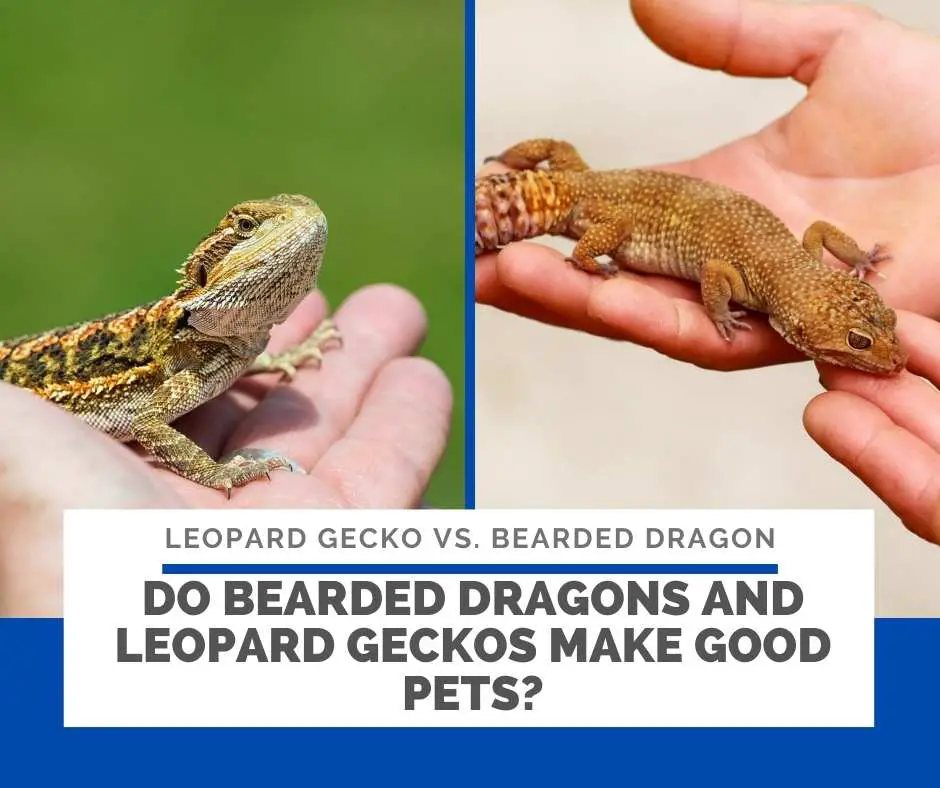
Both bearded dragons and leopard geckos are a perfect pet choice for beginners and expert hobbyists alike. This is why they are among the most common and popular pet lizards available in the market.
Both of them have fascinating behavior, which is exciting and fun to watch.
Furthermore, they are calm and docile and will thrive and live longer if you give them the best care. It is easy to get their food, and they require little care.
The best thing about them is that you can easily prevent common health problems common to them with proper diet and enclosure conditions.
Bearded Dragon Vs. Leopard Gecko – Which One Is A Better Option?
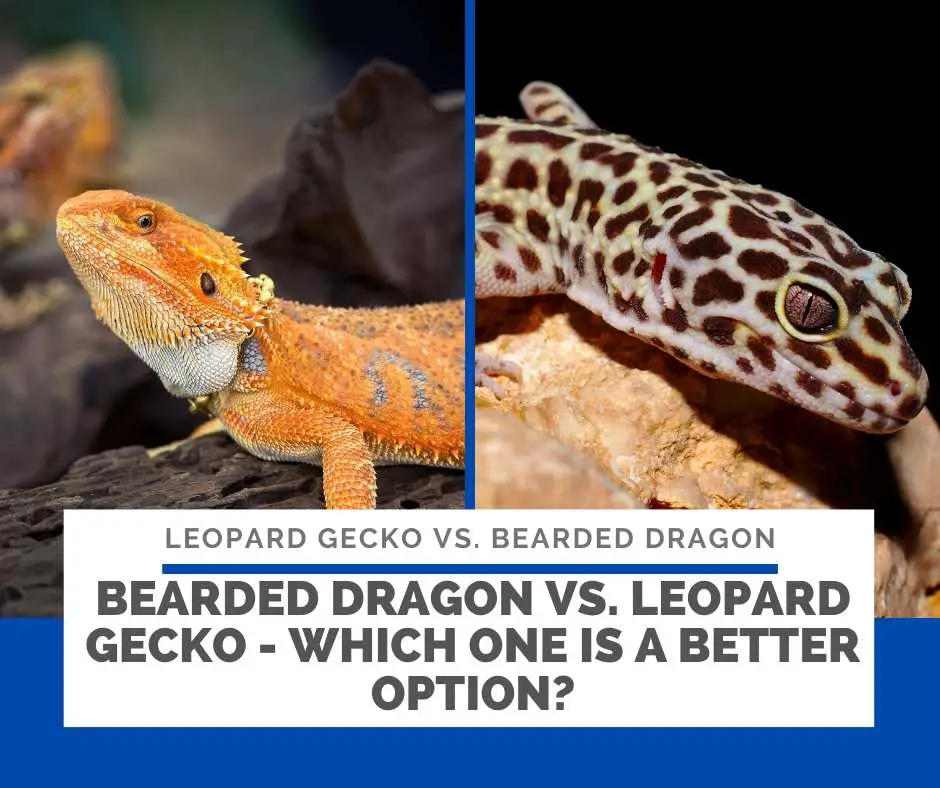
Depending on your choice, both leopard geckos and bearded dragons are amazing pets. You can choose leopard gecko because they are easy to maintain, and they are an amazing display pet. Whereas bearded dragons are better for young people as they can show more personality.
Both leopard geckos and bearded dragons are a perfect pet for beginners. However, bearded dragons will take more of your time, especially if you are still learning about how to care for them.
But leopard geckos are easier to care for because they require less feeding, do not need special lighting, and will not even take too much space. Bearded dragons are more sociable and active during the day while leopard geckos are active at dawn or dusk, and you can handle them.
Physical Appearance
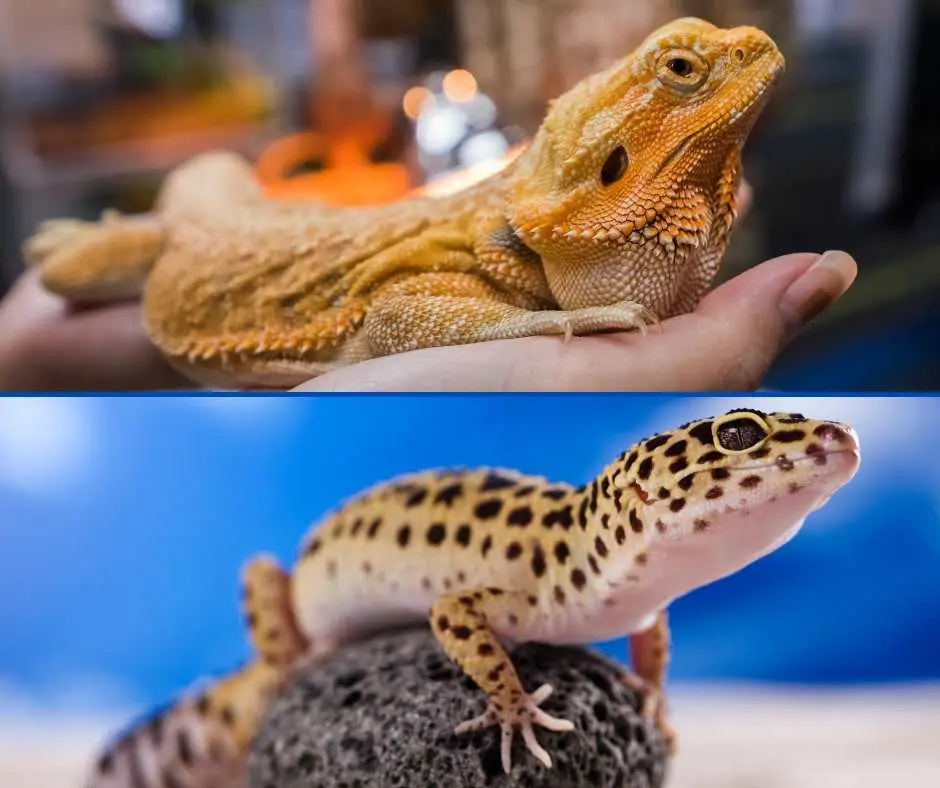
Leopard geckos are beautiful creatures. Their body is covered in dots, and you will love their thick tail and stunning eyes. Leopard geckos are available in different color morphs and even eye colors.
Bearded dragons look similar to a dragon, and they have a beard that they can puff up whenever they feel threatened. There are small but not sharp spikes on their body. Similar to leos, they also come in different morphs.
This indicates that both leos and beardies are beautiful. However, beauty lies in the eyes of the beholder.
Personality
Leopard geckos have unique personalities, and they are fascinating animals to bond with. They have docile temperaments and are shy creatures. Although it is not all that will be a fan of handling, most love handling, and you can do varieties of activities with your gecko.
Bearded dragons are also fun and lovely pet lizards with unique personalities. They have docile temperaments and love spending time with their owners. The best thing is that you can take them outside during the summer period and do different activities.
Although both reptiles have lovely personalities, bearded dragons are more sociable and will love bonding with their owner.
Space
Leopard geckos do not need a lot of space to thrive well. Young leos can live in a small 10-15 gallon tank while adult leopard geckos can live in a 25-30 gallon wide terrarium.
However, young bearded dragons can live in a small 15-gallon tank for only 1-2 months. Adult bearded dragons need a 55-70 gallon tank that is about 26 inches long to thrive well.
This means that leopard geckos can stay in less space than bearded dragons. You will need to provide both reptiles with a wide horizontal tank than the vertical ones.
Humidity, Lighting, and Heating
Leopard geckos do not have specific heating and lighting requirements. All you need is to ensure the room with the tank is warm, and you don’t need to heat the tank. However, you need to provide a basking area with a temperature range between 83-90 degrees Fahrenheit.
You will need to provide your leos with an under-tank heater or heat cable because they need belly heat for digesting their food.
On the other hand, bearded dragons need a hot basking spot with a constant temperature between 92-110 degrees Fahrenheit. You will also provide a high output UVB that will run across 50-80% of the tank. Bearded dragons need heat for staying healthy and digesting food.
This indicates that it is very easy to set up heating and lighting for leopard geckos, unlike bearded dragons. Although both need low humidity levels, leopard geckos need a warm tank for digesting food, while bearded geckos need a lot of heat to digest food and stay healthy.
Ability To Live In Groups
Leopard geckos are not social animals, and you need to avoid putting them together. This is because they will start fighting for food, space, and even attack each other.
Bearded dragons should live on their own. Even any cohabitation with any gender will surely cause problems and injuries. This is because beardies are territorial and prefer living alone for a happy life.
This shows that you need to house each leopard geckos or bearded dragon separately.
Lifespan
Leopard gecko’s lifespan can vary from 10 to 20 years. Females or leos that are not properly cared for can live for as little as seven years. However, with good care, leopard geckos can live up to at least ten years.
Furthermore, a bearded dragon has a lifespan between 10 to 15 years with good care. But the average lifespan of beardies is between 7 to 12 years.
This implies that both bearded dragons and leopard geckos have a similar lifespan. However, leos can live longer if you give it exceptional care.
Diet
Leos are strictly insectivorous animals, and it is best to feed them with only live food. There is a wide range of live foods that you give your gecko, and you can add freeze-dried insects to their diet at some time. Young leos will eat once a day, while adult geckos will eat once in two days.
However, bearded dragons are omnivores, and they can eat both live food and plants. You will need to feed young beardies with food that is mainly live insects.
As they grow to about 10-12 months, you can feed them with mainly vegetables and greens, but bugs will be limited to only two times a week. Baby bearded dragons will eat 2-4 times a day but once a day after it reaches maturity at about 12 months.
This shows that leos will only feed on insects, and you will need to spend more on live food. In contrast, bearded dragons will eat mainly greens after reaching maturity.
Size and Weight
Size
Leopard geckos are usually smaller than bearded dragons. Newborn leos can grow to about 7.6 to 9 cm long while adult leos can grow to about 17.8 to 25.4 cm long. However, bearded dragons are medium-sized lizards, and adult beardies can grow to around 43 to 61 cm.
A newly hatched bearded dragon can grow to around 9 to 10 cm and will grow until it reaches full maturity. Furthermore, there are also dwarf bearded dragons that can grow to about 25-35.6 cm long. However, German giant bearded dragons can even grow bigger to about 56 to 61 cm long.
Weight
Adult leos can weigh about 45 to 65 grams, but some can grow to about 100 grams. You should note that males are usually heavier than females. However, beardies will weigh about 2-3g at hatching.
Adult beardies can weigh about 250 to 850 grams, but anything above that is obesity.
Best Option For Beginners
Both the leopard gecko and bearded dragon are a perfect beginner pet. But you will need some work to set up lighting and heating for bearded dragons.
Egg-laying
At about 12 months of age, leopard geckos will become sexually mature. But you need to ensure that your leos weigh about 50g before you will start breeding them. Furthermore, leos can lay eggs without mating with a male, but the eggs will be infertile.
When your bearded dragons reach about 8-12 months old, it will be mature for breeding. But your beardies will reach about 18-24 months old and weigh about 400g before you breed them. Furthermore, beardies can lay eggs without mating with a male, but the eggs will be infertile.
Can You Keep Bearded Dragons Together With Leopard Geckos?
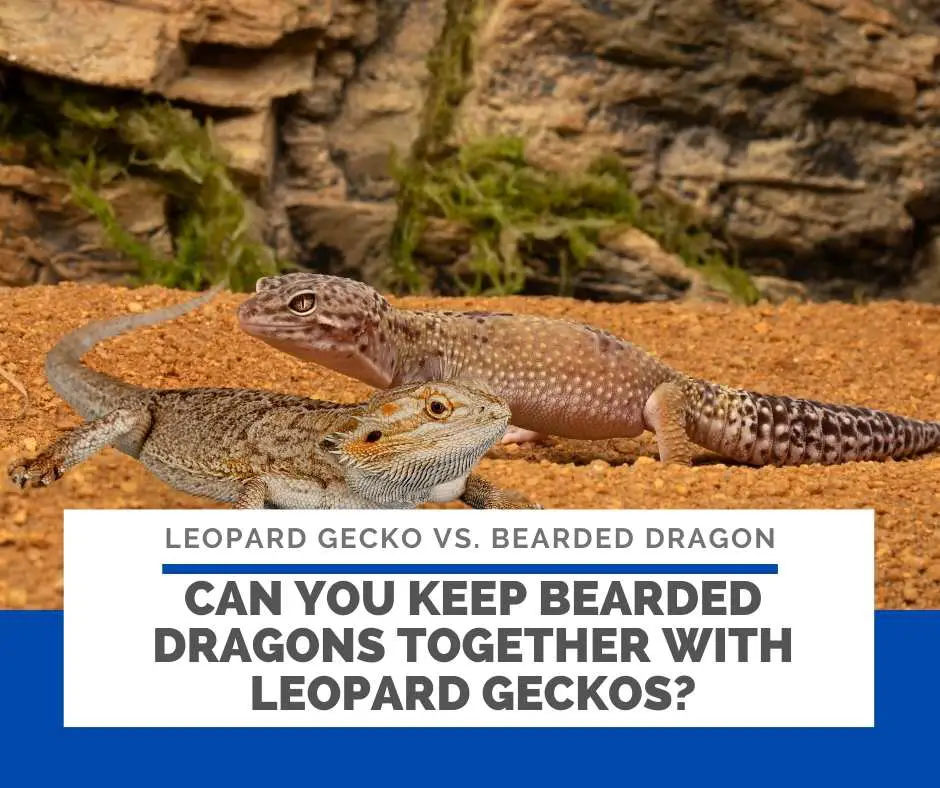
It is best not to keep bearded dragons and leopard geckos together. This is because beardies are bigger than leos, and your bearded dragon can bully or hurt leopard geckos.
Furthermore, housing requirements are different from each other, and it is hard to find a way to find the right condition for both species. Both species can also transmit deadly parasites to each other.
Wrapping Up
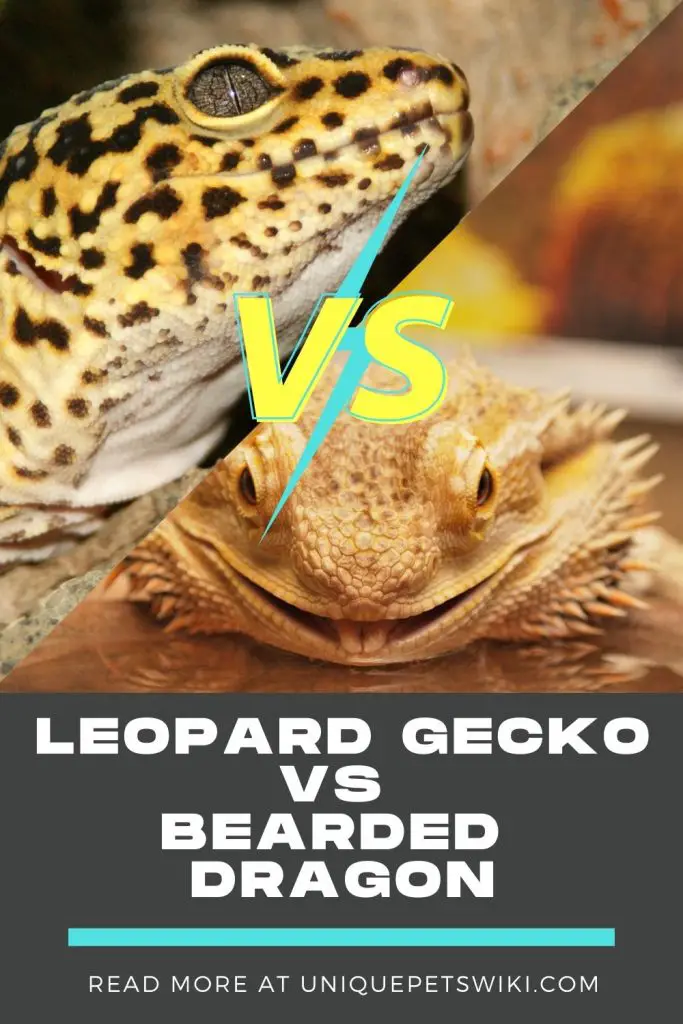
Depending on your preference, you can either choose from both leopard geckos and bearded dragons. This is because they will make amazing pets. However, beardies are more suitable for young people, while juvenile leos may be more challenging for young children.
This is because young leopard geckos have more energy and are fragile and will not like rough handling.
